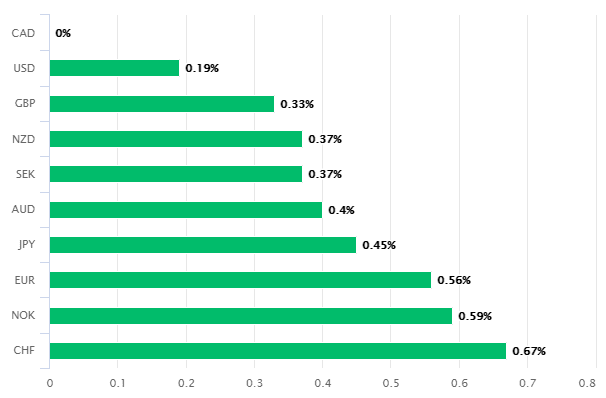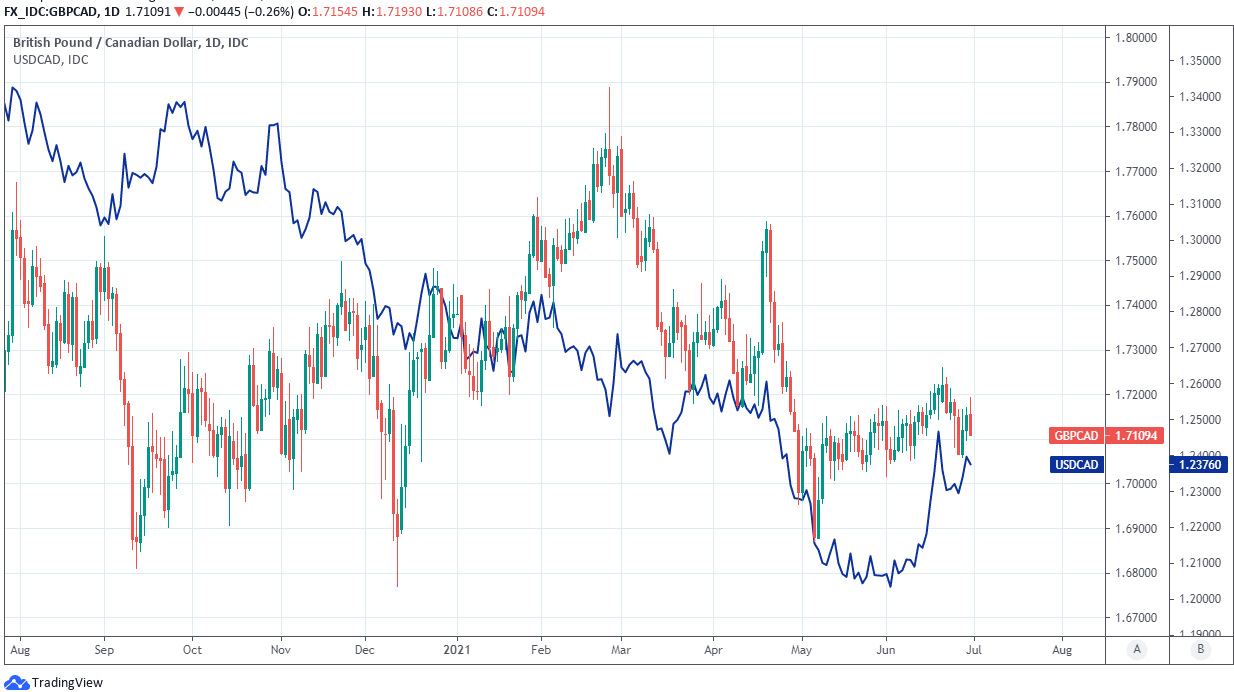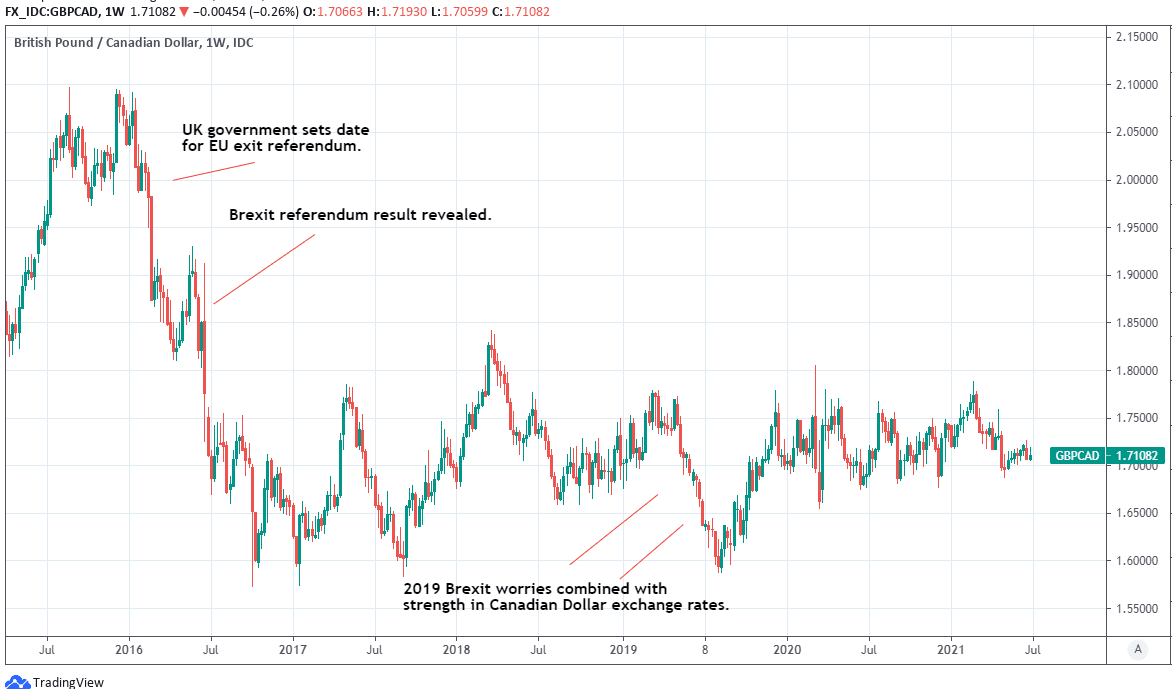Canadian Dollar's Resilient Economy Puts GBP/CAD’s Range Lows On Table
- Written by: James Skinner
-
- GBP/CAD shies away from 1.72, eyes test of 1.71
- As April GDP bolsters CAD’s economic credentials
- Ahead of all-important BoC decision on QE, rates
- GBP/CAD charts tilting bearish amid BoE’s caution

Image © Adobe Stock
- GBP/CAD reference rates at publication:
- Spot: 1.7092
- Bank transfer rates (indicative guide): 1.6494-1.6613
- Money transfer specialist rates (indicative): 1.6940-1.6972
- More information on securing specialist rates, here
- Set up an exchange rate alert, here
The Pound-to-Canadian Dollar rate could be on course for a return to the bottom of its two-month range after Canada’s economy again outperformed market expectations, and now that Sterling is itself taking a timeout from its own earlier recovery rally and associated period of outperformance.
GBP/CAD shied away from near two month highs before sliding to the middle of an eight-week range as a lethargic Sterling ceded ground to the Loonie, which outperformed all other major currencies following the release of Canadian GDP data for the month of April.
“Taken together the two months still showed less of a retreat than anticipated. Pain over the period was again focused in hard-to-distance services, as it was during prior waves of the virus. However, sectors such as construction and mining and quarrying showed strong gains in April,” says Royce Mendes, an economist at CIBC Capital Markets.
Canada’s economy shrank by -0.3% in April, a much lesser decline than the -0.8% anticipated by consensus and in a period where much of the country was clobbered with new restrictions on activity and social contact for coronavirus-related reasons.

Above: Canadian Dollar performance against major currencies on Wednesday.
Secure a retail exchange rate that is between 3-5% stronger than offered by leading banks, learn more.
April’s data was a clear beat against consensus among economists, although it may also have mattered to the Loonie that Statistics Canada said its preliminary estimate for May indicates that the rate of contraction remained a steady 0.3% in May.
“The good news for services most impacted is that, with a reopening already underway across many regions of the country, those businesses should be the ones leading the economy higher this summer,” Mendes says.
It’s possible that the data will enhance the Bank of Canada’s confidence that its forecasts for the economy will be borne out in official statistics over the coming months, and that they haven’t been too optimistic, which would potentially leave Canadian policymakers on track to continue winding down the crisis-inspired government bond buying programme (quantitative easing, QE) that has been crushing yields on Canadian assets since early last year.
Above: Pound-to-Canadian Dollar rate shown at daily intervals with USD/CAD.
That would be supportive of the Loonie and may have to do with why the main Canadian Dollar exchange rate USD/CAD tumbled in afternoon trading Wednesday, which was the move responsible for the much of the Pound-Canadian Dollar rate’s decline from around 1.7180 to 1.7110 on the interbank market: GBP/CAD always closely reflects relative price action in GBP/USD and USD/CAD.
“GBPCAD remains range bound and the broader downtrend in the cross remains intact, with the GBP failing against resistance above 1.72 last week. Weekly price signals suggest a bearish reversal developed at this point,” says Juan Manuel Herrera, a strategist at Scotiabank.
Herrera and the Scotiabank team say that risks are shifting toward the downside for GBP/CAD after last week’s price action saw Sterling retreat from highs not seen since early April only to end the week with its largest one-day loss since early May.
{wbamp-show start}{wbamp-show end}
That came after the Bank of England (BoE) acknowledged a better-than-expected performance from the UK economy in recent months but otherwise took the wind out of Sterling’s sails when in its minutes of June’s meeting the bank noted that it would be important to avoid the kind of “unwarranted tightening of financial conditions” that could arise from misplaced speculation about any prospect of an interest rate rise any time soon.
The Pound-to-Canadian Dollar rate has spent seven weeks since May 11 trading mostly within an unusually narrow two cent range spanning the gap between 1.70 and 1.72, with the pair having made only two failed attempts to break above the upper level.
This reflects a range-bound consolidation that has played out with the Pound and Canadian Dollar vying with each other to claim the top spot among major currencies for 2021, although the Loonie has held that spot throughout the second quarter and is increasingly solidifying its grip on it.
Above: Pound-to-Canadian Dollar rate shown at weekly intervals with selected moving-averages.
Sterling has meanwhile retained a firm grip on the second spot for 2021, but ceded ground to all major currencies in the immediate aftermath of last Thursday’s Bank of England decision, which saw settings of all policy instruments left unchanged, and has lagged many of them in a lethargic manner since.
“By the end of this year, I expect UK inflation to be nearer 4% than 3%. This increases the chances of a high inflation narrative becoming the dominant one, a central expectation rather than a risk,” says Andy Haldane, chief economist at the Bank of England.
“Even if this scenario is a risk rather than a central view, it is a risk that is rising fast and which is best managed ex-ante rather than responded to ex-post,” Haldane later added, in a speech to the Institute for Government on his last day of a 32-year tenure at the BoE.
Haldane was the sole one out of nine BoE policymakers who voted in June to curtail the bank’s quantitative easing programme before it reaches the current £895bn target, which was supplemented with an additional £150bn allocation of newly created money announced in November 2020.











